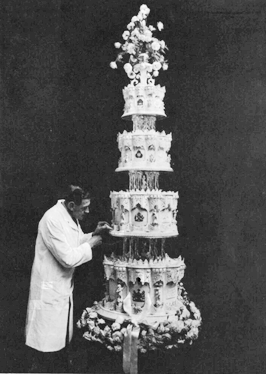Princess Elizabeth and Philip Mountbatten's wedding cakes
Princess Elizabeth and Philip Mountbatten's Wedding Cakes refer to the elaborate confections created for the royal wedding of Princess Elizabeth (later Queen Elizabeth II) and Philip Mountbatten (later Prince Philip, Duke of Edinburgh) on November 20, 1947. The wedding was a significant event in the post-World War II era, symbolizing hope and renewal for the British public and the Commonwealth. The cakes, given their symbolic importance and the austerity of the times, were notable for their craftsmanship, the rationing challenges they overcame, and the international goodwill they represented.
Background[edit | edit source]
The wedding of Princess Elizabeth and Philip Mountbatten took place at Westminster Abbey in a ceremony that captured the world's attention. In the aftermath of World War II, Britain was still under strict rationing, making the lavish celebration a logistical challenge, particularly when it came to the creation of the wedding cakes.
The Cakes[edit | edit source]
A total of 11 wedding cakes were presented to the royal couple, but the centerpiece was a grand four-tiered fruitcake known as "The 10,000 Mile Cake." This nickname reflected the global journey many of the ingredients took to reach Britain, donated by countries from the Commonwealth. The cake stood at nine feet tall and weighed approximately 500 pounds.
Main Cake[edit | edit source]
The main cake was created by McVitie and Price, a renowned British bakery. Its design was intricate, featuring the coats of arms of both families, motifs from the bride and groom's lives, and symbols representing the British Isles and the Commonwealth. The cake also included sugar replicas of the various military regiments associated with Prince Philip.
Ingredients and Challenges[edit | edit source]
Given the post-war rationing, the ingredients for the cake were a testament to the goodwill towards the young couple. Sugar, butter, and flour were scarce in Britain, but countries such as Australia and South Africa sent gifts of sugar and dried fruits to help. The creation of the cake under these conditions highlighted the ingenuity and determination of the British people during a time of hardship.
Distribution[edit | edit source]
After the wedding, slices of the cake were distributed to various schools and institutions across the country, and some were sent to international dignitaries and members of the Commonwealth. This act of sharing was symbolic of the couple's gratitude and the unity of the Commonwealth.
Legacy[edit | edit source]
The wedding cakes of Princess Elizabeth and Philip Mountbatten remain an enduring symbol of the royal wedding and the post-war era. They exemplify the challenges of the time, the international goodwill towards the royal family, and the importance of tradition and ceremony in British culture.
This UK royalty related article is a stub. You can help WikiMD by expanding it.
Search WikiMD
Ad.Tired of being Overweight? Try W8MD's physician weight loss program.
Semaglutide (Ozempic / Wegovy and Tirzepatide (Mounjaro / Zepbound) available.
Advertise on WikiMD
|
WikiMD's Wellness Encyclopedia |
| Let Food Be Thy Medicine Medicine Thy Food - Hippocrates |
Translate this page: - East Asian
中文,
日本,
한국어,
South Asian
हिन्दी,
தமிழ்,
తెలుగు,
Urdu,
ಕನ್ನಡ,
Southeast Asian
Indonesian,
Vietnamese,
Thai,
မြန်မာဘာသာ,
বাংলা
European
español,
Deutsch,
français,
Greek,
português do Brasil,
polski,
română,
русский,
Nederlands,
norsk,
svenska,
suomi,
Italian
Middle Eastern & African
عربى,
Turkish,
Persian,
Hebrew,
Afrikaans,
isiZulu,
Kiswahili,
Other
Bulgarian,
Hungarian,
Czech,
Swedish,
മലയാളം,
मराठी,
ਪੰਜਾਬੀ,
ગુજરાતી,
Portuguese,
Ukrainian
Medical Disclaimer: WikiMD is not a substitute for professional medical advice. The information on WikiMD is provided as an information resource only, may be incorrect, outdated or misleading, and is not to be used or relied on for any diagnostic or treatment purposes. Please consult your health care provider before making any healthcare decisions or for guidance about a specific medical condition. WikiMD expressly disclaims responsibility, and shall have no liability, for any damages, loss, injury, or liability whatsoever suffered as a result of your reliance on the information contained in this site. By visiting this site you agree to the foregoing terms and conditions, which may from time to time be changed or supplemented by WikiMD. If you do not agree to the foregoing terms and conditions, you should not enter or use this site. See full disclaimer.
Credits:Most images are courtesy of Wikimedia commons, and templates Wikipedia, licensed under CC BY SA or similar.
Contributors: Prab R. Tumpati, MD




